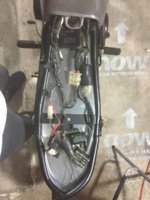Ezetman
XS400 Enthusiast
Is this battery too small (4 celll Antigravity Battery)? Hell, is an 8 cell too small?
They also detail in their specs that bikes mid 80's or older should upgrade to a modern voltage regulator.
Has any one done the conversion to these Lithium batteries before, how'd it work out?
I laid out the wiring harness last night under my seat and I have limited space for the battery as you can see so the 4 cell would prob make it easier for me to fit but I want to make sure it won't be too hard to troubleshoot any other issues that may come up from switching batteries.

They also detail in their specs that bikes mid 80's or older should upgrade to a modern voltage regulator.
Has any one done the conversion to these Lithium batteries before, how'd it work out?
I laid out the wiring harness last night under my seat and I have limited space for the battery as you can see so the 4 cell would prob make it easier for me to fit but I want to make sure it won't be too hard to troubleshoot any other issues that may come up from switching batteries.



